Lancaster Excavation - Specialist Excavation Solutions in Lancaster, OH
Lancaster Excavation - Specialist Excavation Solutions in Lancaster, OH
Blog Article
Unveiling the Art of Excavation: Pro Tips for Safe and Productive Digging
In the realm of excavation, the proficiency of secure and productive digging is an art type that requires expertise, precision, and adherence to well-known practices. As soil is turned and earth is moved, the ins and outs of excavation expose themselves, demanding an eager understanding of equipment, soil make-up, safety and security procedures, and environmental factors to consider. The experience needed to navigate these components efficiently can mean the difference in between a successful excavation job and a possible disaster. By untangling the layers of this intricate process, a globe of techniques and understandings waits for those seeking to elevate their excavation abilities to brand-new heights.
Value of Correct Equipment
To make certain the safety and performance of any excavation task, using the suitable tools is critical. Excavation jobs differ in range and intricacy, ranging from little property landscape design work to massive building and construction undertakings.
These versatile machines come in numerous sizes to suit various job needs. Miniature excavators are perfect for smaller jobs, while larger excavators tackle a lot more considerable projects successfully.
Besides excavators, various other important devices consists of dump bulldozers, trucks, and trenchers. Discard trucks are necessary for getting rid of and carrying excavated materials, while plates are utilized for digging narrow and deep trenches. Excavators master jobs that require pressing big quantities of dirt or particles. By purchasing the suitable tools, excavation jobs can be finished securely, on time, and with accuracy.
Understanding Dirt Make-up
An extensive grasp of dirt structure is basic for performing excavation tasks with precision and safety. Recognizing the various kinds of soil is critical as it straight impacts excavation approaches, tools option, and overall task performance.
Sand bits are the largest and supply great drain yet provide little cohesion. Silt particles are smaller sized than sand however larger than clay, offering modest water drainage and communication. Clay fragments are the smallest and offer high cohesion but poor water drainage. Raw material, such as decaying plant material, impacts dirt fertility and security.
Before beginning excavation, performing dirt examinations to identify its composition and qualities is essential. This information helps in selecting the suitable devices, carrying out safety and security actions, and establishing excavation strategies customized to the details soil problems - lancaster trenching. By comprehending dirt structure, excavation specialists can boost task outcomes while guaranteeing safety and security and adherence to best techniques
Precaution and Protocols
Understanding soil composition is the foundation whereupon safety and security procedures and procedures for excavation projects are built, making certain the well-being of workers and the success of the undertaking. When it comes to security throughout excavation, there are several essential actions that have to be executed to alleviate risks and prevent accidents.
Primarily, prior to any type of excavating commences, a detailed inspection of the site must be conducted to identify any possible risks such as below ground energies, unstable dirt problems, or nearby frameworks that can posture a danger. It is important to have a competent person oversee the excavation process to make certain that all security methods are complied with purely.
In addition, all employees associated with the excavation has to be correctly educated in safe digging methods and the correct procedure of tools. Individual safety devices (PPE) such as tough hats, high visibility garments, gloves, and safety and security boots should be used whatsoever times to minimize the threat of injuries. lancaster excavation. Routine safety conferences and tool kit talks must also be conducted to maintain all employees informed concerning potential dangers and strengthen risk-free work techniques. By adhering to these precaution and protocols, excavation projects can be finished successfully and without case.
Reliable Excavation Preparation
When beginning on an excavation task, meticulous preparation is vital to ensure performance, safety, and effective end results. Effective excavation planning includes a number of crucial steps that Homepage are critical for the smooth implementation of the job.
Once the site evaluation is complete, the following action is to produce a clear timeline and routine for the excavation activities. This consists of figuring out the series of tasks, tools needs, and workforce appropriation. Appropriate scheduling helps prevent delays and makes sure that the task remains on track.

Additionally, interaction among all team participants is paramount throughout the planning phase. Clear directives, regular updates, and efficient sychronisation are crucial for an effective excavation job. By investing effort and time in meticulous planning, excavation teams can substantially improve productivity, reduce threats, and attain effective outcomes.

Handling Ecological Factors To Consider
With enhancing emphasis on environmental sustainability in construction techniques, taking care of ecological factors to consider has come to be an essential aspect of more helpful hints excavation jobs. Excavation activities have the possible to impact the surrounding environment with soil disintegration, sediment runoff, environment disturbance, and contamination of water sources. To mitigate these dangers, it is important to carry out finest techniques that prioritize environmental management.

Furthermore, correct waste management is essential to protect against dirt and water contamination. Executing treatments for the disposal of dangerous materials, recycling of waste products, and decreasing using dangerous chemicals can significantly decrease the environmental effect of excavation projects. By integrating these techniques right into excavation planning and implementation, building business can ensure that their jobs are not only safe and productive but likewise environmentally liable.
Final Thought
To conclude, mastering the art of excavation requires a detailed understanding of proper tools, dirt make-up, safety and security steps, and effective preparation. By following these guidelines and taking into consideration ecological variables, my blog excavations can be conducted safely and effectively. It is vital to focus on safety and performance in every excavating job to guarantee successful end results.
As dirt is turned and earth is moved, the details of excavation reveal themselves, requiring an eager understanding of devices, soil make-up, security protocols, and ecological considerations.To guarantee the safety and security and performance of any kind of excavation task, making use of the proper tools is extremely important.A detailed understanding of dirt structure is fundamental for executing excavation projects with precision and safety. Recognizing the various types of dirt is critical as it straight impacts excavation methods, devices selection, and total job efficiency. By understanding soil structure, excavation specialists can enhance task results while guaranteeing security and adherence to finest practices.
Report this page